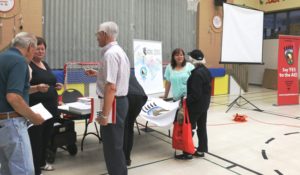Nipissing citizens receptive to Anishinabek Education System information session

By Laura Barrios
NIPISSING FIRST NATION—Citizens from Nipissing First Nation gathered at Nbisiing Secondary School for an information session regarding the Anishinabek Nation Education Agreement (ANEA) on Wednesday evening.
The ANEA is the largest self-government agreement in education that Canada has been involved with. The proposed Anishinabek Education System (AES) has been created by Anishinabek for Anishinabek.
Legal counsel Tracey O’Donnell was part of the over 20-year long negotiating process and is now facilitating community information sessions about the ANEA all across Anishinabek Nation territory.
O’Donnell discussed some of the shocking realities that the Anishinabek students are faced with. She stated that the AES will be the hope to “change some of the realities that exist right now for the Anishinaabe today.”
One of the realities that O’ Donnell mentioned is that non-Indigenous students have a 72% graduation rate, whereas First Nations students have 36%. She then drew comparison between the Canadian graduation rates and the Mi’kmaq who have their own education system in place with the average graduation rate of 90%. These numbers are achievable for the Anishinabek students if a culturally appropriate curriculum is implemented. She added that currently, nine out of 10 non-Indigenous students graduate high school; seven out of 10 First Nations students living off reserve graduate high school; and only four out of 10 First Nation students living on reserve graduate high school.
Monique Sawyer,Principal of Nbisiing Secondary School, a school that is an example of how a First Nation education is successful, and she sees firsthand how cultivating and developing a cultural identity is directly correlated to student success.
“As First Nations people, I believe we must move forward, otherwise, we will remain stagnant in a system that has not effectively addressed the needs of all of our students,” stated Sawyer. “We have to do what we know is best, based on informed practice.”
Deputy Chief Muriel Sawyer was also in attendance and fully believes that the proposed AES is going to change relationships with the current education bodies and that change will permit Anishinabek students to grow in the local high schools.
“It’s a lot of hard work through a handful of people that believe in a vision and don’t stray from that vision, who continue to work for the outcome in that vision…we can only hope that it’s going to be a favourable vote,” stated Deputy Chief Sawyer. “It’s been such a long time in the making.”
In order to have a successful vote, all eligible voters need to get informed about the proposed AES.
The AES will provide students with an education that will help them build better lives while also gaining a better understanding of what it means to be Anishnaabe with a system designed and governed by the Anishinabek.
For those interested in acquiring further information regarding the Anishinabek Education System, information sessions, or general information, they are encouraged to visit: sayyestoaes.ca or to call 1-877-497-3799.
The vote for the Anishinabek Nation Education Agreement will take place November 28th – December 2nd, 2016.

